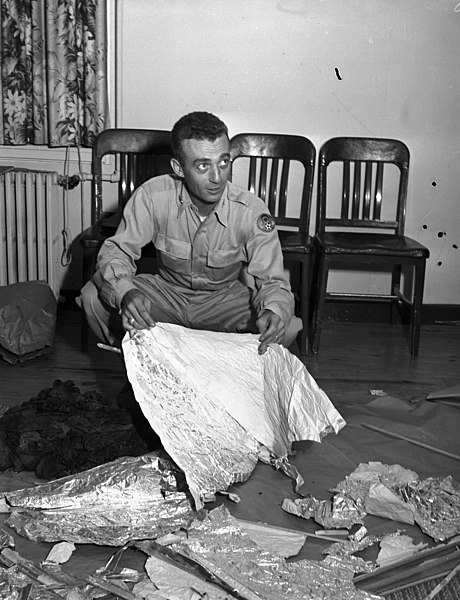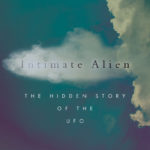The Chinese Spy Balloon and the UFO – Echoes of Roswell?
First there was one–the Chinese balloon first tracked over Alaska, making news as it drifted over Montana, then finally shot down off the coast of South Carolina. Now there seem to have been three more, genuine “unidentified flying objects” since they were airborne and we don’t know what they were or what they were doing […] The post The Chinese Spy Balloon and the UFO – Echoes of Roswell? first appeared on David Halperin.

First there was one–the Chinese balloon first tracked over Alaska, making news as it drifted over Montana, then finally shot down off the coast of South Carolina. Now there seem to have been three more, genuine “unidentified flying objects” since they were airborne and we don’t know what they were or what they were doing in the skies of North America. Not “UFOs,” however, in the sense that the word has acquired.

Probably not. Almost certainly not. But General Glen VanHerck won’t rule it out, and his refusal has made headlines. (“U.S. General Doesn’t Rule Out Aliens After Military Shoots Down Unidentified Objects.“) Which shows you where people’s minds go when they hear about unidentified objects in the skies.
If the commander of NORAD refuses to speculate what these things are, I’m not going to try. But as an old UFOlogist, I have to say: this feels like deja vu to 1947.
Not that I was around, except as a fetus in the womb, in the summer of 1947 when “flying saucers” erupted into the news in the wake of the June 24 sighting by Kenneth Arnold that kicked off the modern UFO era. But as a teenager I sifted through the microfilms of old New York Timeses in the Newspaper Room of the Philadelphia public library, and looked back wistfully on those few weeks when the all-the-news-that’s-fit-to-print newspaper deemed mysterious objects in the skies to be front-page news.
What I didn’t grasp was that back then “flying saucers” didn’t automatically mean “men from Mars.” The idea that the strange objects might be extraterrestrial had indeed been floated, but was far from the dominant position. It seemed far more likely that they were secret human devices, either ours or–God forbid–the Russsians’.
The Cold War was in its early stages. Who knew what amazing aerial devices the Nazi scientists might have been developing when the Third Reich came crashing down, two years earlier? Who knew what blueprints, and what experts in putting them into operation, might have fallen into Soviet hands? If Stalin had the capability to send those nine silvery disks zooming at speeds above 1200 mph among the Cascade Mountains of Washington, where Arnold spotted them–well, that was big news indeed. And about as scary in its implications as news could be.
Turned out, of course, that it wasn’t true. We could all breathe a sigh of relief. For the Times, UFOs became a silly joke, to be greeted with the collective sneer of contempt that the newspaper was to maintain from then on–until its abrupt change of course at the end of 2017. (But that’s another story, which I’ve written about in earlier posts.)
1947 was also the summer of Roswell, New Mexico. And the debris that stirred up the brief excitement 75 years ago is oddly mirrored in today’s Chinese balloon.
The Roswell story is convoluted and in many places obscure. What is known for sure is this: that about noon on Tuesday, July 8, 1947, the public information officer at Roswell Army Air Field issued an announcement that “the many rumors regarding the flying disc became a reality yesterday” when the base intelligence office got hold of a disk that had “landed on a ranch near Roswell sometime last week.” (Note well: “landed,” not crashed.) The disk, the announcement went on, had been flown to “higher headquarters”––Fort Worth Army Air Field in Texas– for further examination.

Then, later that same afternoon, a reporter from a Fort Worth newspaper was invited to the office of the commanding general at the base, where he photographed the general and his chief of staff posing with the wreckage of what had obviously been a weather balloon, and looking thoroughly pleased with themselves. That was what the “flying-disk” kerfuffle had been about, the officers explained: an ordinary weather balloon.
What led the officers at Roswell to announce they’d acquired a landed disk, when there was no way they had anything more than a pile of debris–whether terrestrial or extraterrestrial, it was still debris–has never been satisfactorily explained. But it’s possibly to imagine an answer to a related question: if the stuff that came down on Mack Brazel’s ranch was so obviously the remains of a balloon, why did the military men get so excited over it?
Let’s imagine they knew from the start they were dealing with a balloon–but whose? Ours? Or might it be possible that the Soviets had established a nest of spies on the other side of the Mexican border, from which they sent balloons to spy out our military installations? Such suspicions might be extreme and groundless, but at the start of the Cold War they couldn’t be dismissed as paranoid. Until they could be laid to rest–as they soon were–the debris on the Foster ranch was serious and perhaps dangerous business.
There’s a piece of direct evidence that this is what happened. Years afterward, the woman who’d been the wife of the commanding officer of the Roswell base remembered that her husband thought the debris “might be Russian because of the strange symbols on it. Later on, he realized it wasn’t Russian either.” (These “strange symbols,” sometimes called hieroglyphics, turn up again and again in accounts of the Roswell debris. What they might have been, is another of Roswell’s enduring enigmas.)
Of course, there are differences between then and now. History may repeat itself, but never quite exactly. The Russian spy balloon at Roswell was a conjecture, soon to be (thankfully) discredited. The Chinese balloon over Montana was all too real, acknowledged–though claimed to be, well, a weather balloon–by the Chinese government. As I write these words, our Secretary of State and theirs have just come from facing off over it.
Grim herald of a new Cold War? We must wait and hope.

by David J. Halperin
Learn more about David J. Halperin on LinkedIn: www.linkedin.com/in/davidjhalperin
Connect to Journal of a UFO Investigator on Facebook at: https://www.facebook.com/JournalofaUFOInvestigator
My book Intimate Alien: The Hidden Story of the UFO–published by Stanford University Press, chosen as a finalist for the 2021 RNA Nonfiction Book Award for Religion Reporting Excellence, sponsored by the Religion News Association.
Don’t have time to keep checking my blog? Sign up for my monthly email newsletter, with summaries and links to the past month’s posts, plus oldies-but-goodies from the archive.
The post The Chinese Spy Balloon and the UFO – Echoes of Roswell? first appeared on David Halperin.
What's Your Reaction?










![The Usability Testing Playbook [Expert Tips & Sample Questions]](https://www.hubspot.com/hubfs/usability-testing-1-20250305-3357250.webp)






























.png)






































